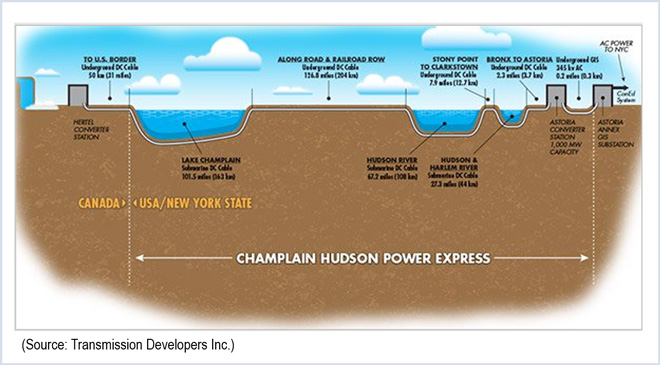
The ISO and other stakeholders filed comments last week in response to a December complaint by transmission owners, who said NYISO’s market power rules are being misapplied to unsubsidized, competitive projects entering the ISO’s capacity market (EL15-26).
In its response, NYISO essentially asked FERC to order a rule change it was unable to achieve through its stakeholder process, where it was blocked by opposition from generators.
The transmission owners — Consolidated Edison of New York, Orange and Rockland Utilities, New York State Electric and Gas, Rochester Gas and Electric and Central Hudson Gas and Electric — told FERC on Dec. 4 that NYISO should amend its Tariff to include a competitive entry exemption in its BSM rules. The exemption would ensure that projects that did not have contracts with, or receive financial support from, any New York distribution companies, municipalities or the state government are not subject to an offer floor in the ISO’s capacity auctions.
TDI Holdings filed a separate complaint Dec. 16 asking FERC to exempt its high voltage, direct current Champlain Hudson project from the BSM rules after NYISO said it would be subject to the offer floor (EL15-33). The $2.2 billion project would deliver 1,000 MW from the Canadian border to the New York City metropolitan area. TDI said subjecting the project to the offer floor — a minimum clearing price — would jeopardize its commercial viability “because generation supply in Canada may be unwilling to execute transmission service agreements with TDI.”
Supporting TDI’s filing, the transmission owners said the project “emphasizes the need for the commission to grant the [TOs’] competitive entry exemption complaint.” At the same time, the group asked FERC to put off ruling on TDI’s complaint until it ruled on theirs, saying that if it were successful, TDI would not need a project-specific exemption.In their complaints, both the TOs and TDI say they recognize the need for BSM rules in preventing market power.
Buyer-Side Mitigation
NYISO’s rules are similar to PJM’s minimum offer price rule (MOPR).
The rules, approved by FERC in 2013, are intended to prevent state and local governments and large net buyers of capacity — market participants whose load dwarfs the amount of capacity they own — from subsidizing the entry of “uneconomic” generation projects into the capacity market in order to artificially lower prices.
A project is considered economic if its average forecasted price exceeds its net cost of new entry (CONE), or if the annual forecasted revenues in NYISO’s Installed Capacity (ICAP) Spot Market Auction exceed the default net CONE in the project’s locality. The default net CONE is defined as 75% of the net CONE of the reference unit used to determine that locality’s ICAP demand curve.
Uneconomic projects are subjected to the offer floor, defined as the lower of either its net CONE or the default net CONE.
Responses to Complaints
NYISO stakeholders filed comments both in support and in protest to the complaints last week.
In its comments, NYISO said it supported the TOs’ complaint, save for a few minor details. The ISO had proposed a competitive entry exemption last February, but it failed to gain the necessary 58% sector-weighted vote from the Management Committee.
“The NYISO asks that the commission: (i) replace certain proposals in the complaint with alternatives previously advanced by the NYISO in its stakeholder process; and (ii) direct the NYISO to adopt additional Tariff language that will be needed if the competitive entry exemption is to be legally effective and practicably implementable,” the ISO wrote.
It also echoed the TOs’ response to TDI, saying the company should wait until FERC rules on the broader exemption.
NYISO said that BSM rules are intended to prevent uneconomic entry, not protect market participants from competition. The ISO “believes that the BSM rules provide necessary protections to the market and that adding a competitive entry exemption would be entirely consistent with their purpose,” it said.
NYISO’s Market Monitor also supported the exemption, noting that it has proposed such a measure in its past three State of the Market reports.
New York City also voiced its support. “For many years, and in multiple proceedings before the commission and at the NYISO, the city has argued that the NYISO’s buyer-side mitigation rules are overbroad and serve more as a barrier to new entry than a protection against market abuses,” the city said. “Indeed, incumbent generating companies have wielded the mitigation rules as a sword (to strike against potential competitors) and a shield (to block new entry).”
Other stakeholders opposed the rule change.
“At first blush this proposal may seem harmless, but it would in fact create a myriad of new opportunities to artificially suppress capacity pricing in NYISO where out-of-market interference in the markets already is pervasive,” Entergy Nuclear Power Marketing said in its protest to the TO’s complaint.
“While couched in the guise of simply permitting ‘purely private investment’ to risk its own money, review of the proposed Tariff revisions reveals that blanket exemptions would be granted to projects that are not, in fact, purely private. The commission should protect the wholesale NYISO capacity market and reject the complaint.”
The Independent Power Producers of New York said “NYISO’s proposal, which was soundly rejected in the stakeholder process as part of a package of exemptions last year, is fatally flawed.”
The BSM rules were proposed by NYISO as a way of dealing with New York’s ongoing struggles with transmission congestion due to the heavy load imposed by the city. The U.S. Department of Energy has called New York City “an epicenter of transmission congestion.”
This also led to a controversial decision by NYISO to combine its five Lower Hudson River Valley capacity zones into one. The move attracted criticism from ratepayers and attention from the state’s U.S. senators. NYISO, however, claimed vindication when it announced last month that the new zone had led generators to reopen 1,900 MW in shuttered power plants. (See Coal-to-Gas Conversions, New Capacity Zone Ease NYISO Reliability Concerns.)



